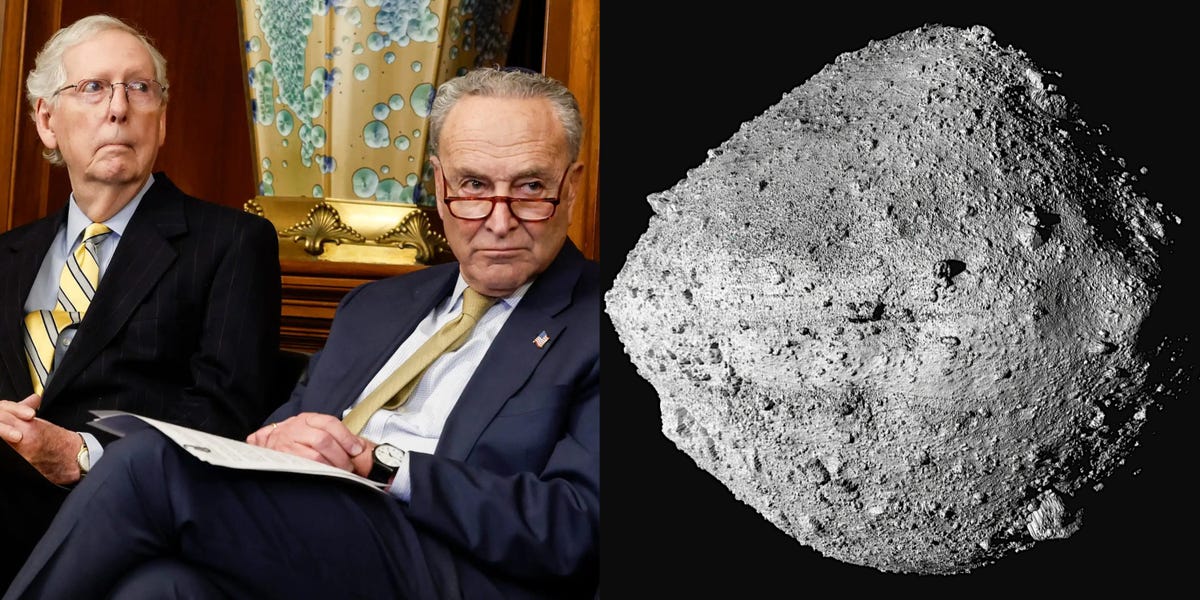- NASA ran a new tabletop simulation of the discovery of a large asteroid heading towards Earth.
- Experts feared that Congress would not appropriate funding for a mission to an asteroid with a 72% chance of hitting Earth.
- This hypothetical scenario highlights a challenge in addressing future threats: politics.
NASA recently brought together about 100 experts to pretend that an asteroid was headed for Earth.
The tabletop simulation presented a hypothetical scenario in which cities such as Dallas, Washington, DC, and Madrid were at risk of a large asteroid impact.
“A major asteroid impact may be the only natural disaster that technology allows humanity to predict and prevent years in advance,” Lindley Johnson, NASA planetary defense officer emeritus, said in a press release.
But it wasn’t clear whether they could have prevented such a catastrophe, even with the 14 years they had had to figure it out.
The simulation showed that technology wasn’t the problem that could ultimately bring down a city, region or entire country. It was politics.
‘I know what I would prefer [to do]but Congress will tell us to wait,” one participant said of their asteroid response plan, in a selection of anonymized comments in NASA’s summary of the exercise, published June 20.
“The main topic of the morning was the discussion about the political nature of decision-making,” said another participant.
Congress may not be moving fast enough
NASA has conducted nearly a dozen tabletop-level simulations since 2013. It took place in May and included participants from the US Department of State, FEMA and the space agencies of Europe, the United Kingdom, Japan and Canada.
Previous exercises have shown that to save the world, NASA needed at least five years’ notice that an asteroid was headed our way, perhaps even ten years.
This time, the simulators learned that even if they had plenty of time, they might not be able to pull off their favored anti-asteroid strike.
That’s because they didn’t think Congress would approve funding for a crucial space mission to study the asteroid “unless the impact became certain,” NASA’s summary said.
A key part of the simulation was figuring out how to convey the “seriousness” of the situation to Congress and other leaders, Johnson said.
Additionally, the fourteen-year timeline spanned multiple budget cycles and presidential elections. At any of these times, the president, Congress, or NASA leadership itself could change priorities and disrupt the asteroid plan.
The most likely scenario for an approaching asteroid
Here are the hypothetical conditions participants were given for this year’s exercise: Scientists have determined a 72% chance that this asteroid will hit Earth within 14 years. It could strike anywhere in North America, Europe, Africa and the Middle East.
The size of the asteroid was unclear. It could have been anywhere from 60 to 800 meters (half a mile) wide — potentially large enough to devastate an entire country.
All that uncertainty made this “a very realistic scenario,” Richard Binzel, a planetologist at MIT who specializes in potentially dangerous asteroids but who did not participate in the simulation, told Business Insider.
“In fact, this is the most likely scenario we’ll face, where an asteroid is discovered and we have limited information,” Binzel said.
Options to prevent an asteroid impact include bombarding the asteroid with lasers, launching a nuclear bomb, or simply launching a space probe to get the asteroid away from Earth.
NASA tested one of these options on a 2022 mission that hit an asteroid and drastically changed its orbit, just to prove the technique could work.
In the simulation, experts wanted more information to understand their anti-asteroid options.
Unfortunately, the fictional space rock was about to disappear behind the sun and disappear from view for seven months. To avoid wasting valuable time, scientists should send a spacecraft to the asteroid to learn more about it.
There, they feared that politics would stand in their way. The participants were not certain that Congress would fund the mission unless the asteroid posed a definite threat—and not a 72% chance of a threat.
So far, NASA has not discovered any large asteroids on their way to impact Earth.
But scientists have identified fewer than 11,000 near-Earth asteroids that are at least 140 meters (460 feet) wide — big enough to destroy a city. They think there are 15,000 in our area, which means more than a quarter of the city’s killers remain undiscovered.
NASA could plan a mission just in case
Binzel says that NASA can clear the political and bureaucratic obstacles now, even before an asteroid threat is identified, by setting up a reconnaissance mission that is ready and waiting.
“It’s something for adults that can protect us from surprises,” he said.
The National Academies of Sciences, Engineering, and Medicine made a similar recommendation in their latest decade-long survey of priorities in planetary science.
In that 2022 report, the Academies said NASA should “develop an approach for a rapid-response, flyby” spacecraft to closely study newly discovered threats. That way, the country could launch a reconnaissance mission in less than three years if needed. The Academies also recommended a demonstration to practice reconnaissance on a real asteroid.
Why isn’t NASA working on this now?
“It’s not in the budget,” Binzel said.
First, NASA must submit a proposal for such a mission, which must be approved by the White House, and then Congress must approve and fund it.
“If there’s an asteroid somewhere with our name on it, it’s already there,” Binzel said. “Fortunately, the chance in the next century is incredibly small. But it is not zero.”
